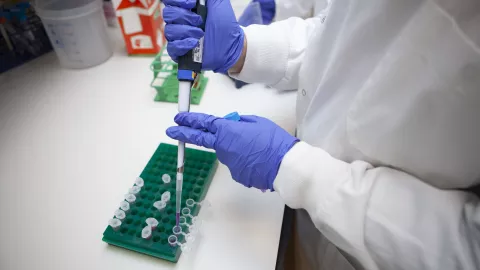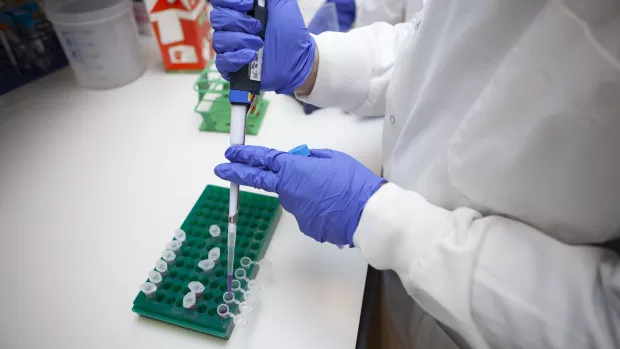
Ocrelizumab
Ocrelizumab works by targeting a type of immune cell (called a B cell). This helps to reduce the immune response by stopping these cells from attacking and damaging myelin.
- Current phase of trial:
- Licensed
Ocrelizumab was licensed by the European Medicines Agency in January 2018 for people with relapsing MS and for people with early primary progressive MS.
In May 2019, after originally rejecting it, NICE approved the use of ocrelizumab for people with early primary progressive MS on the NHS. Over 21,000 people joined our campaign to call for this change. This decision shows how promising research can translate into real world treatment for people with progressive MS.
Ocrelizumab is an intravenous infusion treatment that has been developed by Roche.
Find out more about ocrelizumab
How does ocrelizumab work?
Ocrelizumab works by targeting a type of immune cell (called a B cell). This helps to reduce the immune response by stopping these cells from attacking and damaging myelin.
How is ocrelizumab taken?
Ocrelizumab is taken as an intravenous infusion, given 14 days apart. It's then taken every six months.
Latest research
Relapsing MS
Two phase 3 trials (OPERA I and OPERA II) have shown that ocrelizumab reduces annual relapse rates by around 46% compared with beta interferon after two years. The treatment also reduces the progression of clinical disability by 40%, as measured by the Expanded Disability Status Scale (EDSS).
The trials involved over 1,600 people with relapsing MS. The trial also found that around 50% of people taking ocrelizumab saw no evidence of disease activity (NEDA) in both OPERA I and OPERA II. This was compared with 25-30% of people taking beta interferon.
NEDA is defined as no relapses, no confirmed disability progression as measured by EDSS, and no new or enlarging lesions.
Results were published in December 2016.
Primary progressive MS
A phase 3 trial (ORATORIO) tested ocrelizumab against placebo in 732 people with primary progressive MS.
Results published in December showed that treatment with ocrelizumab reduced the risk of disability progression. The percentage of people with primary progressive MS that had disability progression (measured by EDSS) after 24 weeks fell from 36% without treatment to 30% with ocrelizumab.
Those taking the drug scored better on the time needed to walk 25 feet and ocrelizumab also reduced the rate of brain atrophy (shrinkage) shown on an MRI.
A new phase 3 trial of ocrelizumab is now planned, to look at whether it can help people with primary progressive MS retain the use of their hands and arms. This is especially important for people who use wheelchairs.
The ORATORIO-HAND trial will involve people with primary progressive MS, who may have more advanced disability than in previous trials. They will recruit over 1,000 people, including people who use wheelchairs. It will be the first trial to look at whether a drug can slow down worsening of arm, wrist and hand function in MS.
Earlier research
A phase 2 clinical trial tested the benefits of two doses of ocrelizumab against beta interferon and placebo for 218 people with relapsing MS.
Ocrelizumab reduced the the number of relapses by around 75% and number of active lesions (as measured by MRI) by around 90 compared with placebo over 24 weeks. People taking ocrelizumab also had significantly fewer relapses than those taking beta interferon.
These benefits were maintained in the group that continued to take ocrelizumab for 96 weeks.
What are the side effects of ocrelizumab?
Side effects in MS trials
None of the phase 3 trials reported any unexpected adverse side effects. In the phase 2 relapsing trial, serious side effects were rare and were comparable for all groups. One patient died in the high dose ocrelizumab group but it was unclear as to whether this was connected to ocrelizumab.
However, longer term studies are needed to understand the full safety profile of ocrelizumab. Weakening the immune system increases the risk of infection and of cancer emerging, and doctors have been advised to “stay vigilant”.
In May 2017 Roche reported that a person had contracted progressive multifocal leukoencephalopathy (PML) after switching from natalizumab (Tysabri) to ocrelizumab in April. Right now it is unclear whether PML was linked to use of ocrelizumab, Roche are investigating further. Tysabri has previously been linked to an increased risk of PML.
Side effects in other conditions
Ocrelizumab has also been investigated as a treatment for rheumatoid arthritis and lupus erythematosus, but studies were discontinued due to the number of infections that participants experienced.
How does ocrelizumab compare with current therapies?
The phase 3 trial for relapsing MS showed that ocrelizumab significantly reduced the annual relapse rate and the progression of clinical disability compared with beta interferon.
When will ocrelizumab be available?
Ocrelizumab was licensed for both relapsing and early primary progressive MS in January 2018 by the European Medicines Agency (EMA). The EMA is responsible for licensing drugs in Europe.
Before any drug becomes available on the NHS, it has to be approved by NICE (for England and Wales), the Scottish Medicines Consortium (for Scotland) or the NI Department for Health (for Northern Ireland).
Ocrevus (ocrelizumab) has been approved for relapsing MS across the UK. This is based on comparing its effectiveness and cost with other available treatments.
In May 2019, NICE approved ocrelizumab for people living with early primary progressive MS in England. The NHS in England has 3 months to implement this decision. The company who make the drug say they plan to make ocrelizumab available on the NHS across the rest of the UK as soon as possible. We'll continue to monitor this.



